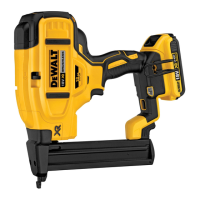ENGLISH
9
provides the maximum delivery of power for driving the
longeststaples.
To operate the stapler in sequential actuation mode:
1. Slide the selector switch
7
to expose the singlestaple
icon .
2. Fully depress nosepiece against the work surface (motor
will start).
3. Pull trigger (staple will drive into work surface).
4. Releasetrigger.
5. Lift nosepiece off worksurface.
6. Repeat steps 2 through 4 for nextapplication.
NOTICE: The contact trip needs to be depressed followed by
a trigger pull for each staple followed by a release of both the
contact trip and trigger after eachstaple.
Bump Action (Fig.E)
Bump action is intended for rapid stapling on flat, stationary
surfaces and typically most effective for applications that
require driving shorterstaples.
When the tool is set in the bump actuation mode, two
methods of tool operation are available: place actuation and
bumpactuation.
Slide the selector switch
7
to expose the triple
staple icon .
To operate the tool using the place actuation method:
WARNING: A staple will be driven each time the trigger is
depressed as long as the contact trip remainsdepressed.
1. Depress the contact trip against the worksurface.
2. Depress thetrigger.
To operate the tool using the bump actuation
method:
1. Depress thetrigger.
2. Push the contact trip against the work surface. As long
as the trigger is depressed, the tool will drive a staple every
time the contact trip is depressed. This allows the user to
drive multiple staples insequence.
WARNING: Do not keep trigger depressed when tool
is not in use. Keep the trigger lock‑off in the locked position
when the tool is not inuse.
WARNING: When the tool’s motor is running, pulling the
trigger or depressing the contact trip will cause a staple to
bedriven.
Preparing the Tool
WARNING: NEVER spray or in any other way apply
lubricants or cleaning solvents inside the tool. This can
seriously affect the life and performance of thetool.
NOTE: The battery pack is not fully charged out of the carton.
1. Read all power tool and stapler safety warnings in
thismanual.
2. Wear eye and earprotection.
3. Ensure magazine is empty of allfasteners.
4. Check for smooth and proper operation of contact trip
and pusher assemblies. Do not use tool if either assembly
is not functioning properly. NEVER use a tool that has the
contact trip restrained in the actuatedposition.
5. Keep tool pointed away from yourself andothers.
6. Insert fully charged batterypack.
Using the Trigger Lock-off (Fig. F)
WARNING: To reduce the risk of serious personal injury,
do not keep trigger depressed when tool is not in use. Keep
the trigger lock‑off switch LOCKED (Fig.F) when the tool is
not inuse.
WARNING: To reduce the risk of serious personal injury,
lock off trigger, disconnect battery pack from tool and remove
staples from magazine before makingadjustments.
Each DeWALT stapler is equipped with a trigger lock-off
2
which when pushed to the right as shown in FigureF,
prevents the tool from firing a staple by locking the trigger
and bypassing power to themotor.
When the trigger lock-off is pressed to the left, the tool will
be fully operational. The trigger lock-off should always be
locked off whenever any adjustments are made or when
tool is not in immediateuse.
NOTICE: Do not store tool with battery pack installed. To
prevent damage to the pack and to ensure best battery
life, store battery packs out of the tool or charger in a cool,
drylocation.
Loading the Tool (Fig. G)
WARNING: Keep the tool pointed away from yourself and
others. Serious personal injury mayresult.
WARNING: Always remove battery pack before loading or
unloading staples. Serious personal injury mayresult.
WARNING: Never load staples with the contact trip or
trigger activated. Personal injury mayresult.
1. Press magazine latch
15
and open sliding
magazine
6
fully.
2. Ensure staple is loaded so that crown of staple sits
against inside surface of magazine
6
.
3. Close sliding magazine until the magazine latch
clipssnuggly.
Unloading the Tool (Fig. G)
WARNING: The trigger lock‑off should always be locked
off whenever any adjustments are made or when tool is not
inuse.
1. Press magazine latch
15
and open sliding
magazine
6
fully.
2. Tip the tool up until the staples slide freely out of the
bottom of the magazine.
3. Check to ensure no loose staples remain inside magazine.
4. Close sliding magazine fully.
Dryfire Lock Out Feature (Fig. A)
Tool is equipped with a dryfire lock out feature to prevent
tool from cycling when there are no fasteners loaded. When
no fasteners are visible in the fastener window
16
, the tool
is running low on fasteners. If this happens, the tool will
be locked out and will not actuate until more staples are
loaded. (Refer to Loading the Tool.)
Adjusting Depth (Fig. H)
The depth that the fastener is driven can be adjusted using
the depth adjustment wheel
3
on the side of thetool.
WARNING: To reduce risk of serious injury from
accidental actuation when attempting to adjust depth,
ALWAYS:
• Remove batterypack.
• Engage trigger lock‑off.
• Avoid contact with trigger duringadjustments.
1. To drive the staple shallower , rotate the depth
adjustment wheel
3
away from the nose of thestapler.
2. To sink a staple deeper , rotate the depth adjustment
wheel
3
toward the nose of thestapler.

